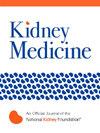IF 3.2
Q1 UROLOGY & NEPHROLOGY
引用次数: 0
摘要
研究理由和目标在针对透析依赖型慢性肾病(DD-CKD)和CKD相关贫血患者的全球3期INNO2VATE项目(2项试验:新入组患者[NCT02865850]和已接受维持性透析的患者[NCT02892149])中,在心血管安全性和血红蛋白疗效方面,伐杜司他不优于促红细胞生成药物darbepoetin alfa。在此,我们调查了积极判定的血管通路血栓(VAT)事件的组间差异。研究设计第 3 期全球性、开放标签、随机、主动对照临床试验。结果在 INNO2VATE 项目中,基线时有 3,590 名(92.0%)随机患者接受血液透析:2,709 名(69.4%)通过动静脉内瘘,340 名(8.7%)通过动静脉移植。在 6468 个患者年(PY)的随访期间,266 名患者中发生了 426 起经积极判定的 VAT 事件,其中 146 人随机接受了伐杜司他治疗,120 人随机接受了达贝泊汀α治疗。相应的首次 VAT 发生率分别为每 100 PY 4.79 例和 3.86 例(率差,0.94;95% CI,-0.10 至 1.97;危险比 [HR],1.27;95% CI,0.99-1.62)。当考虑首次和复发事件时,伐杜司他组和darbepoetin alfa组的VAT率分别为6.58和6.59/100 PY(率差,-0.01;95% CI,-1.26至1.24;HR,1.00;95% CI,0.83至1.21)。结论在这项对接受血液透析的DD-CKD和CKD相关贫血患者进行的INNO2VATE项目二次分析中,接受伐杜司他治疗的患者首次VAT率在数量上高于接受达泊西汀α治疗的患者,但在统计学上没有差异。3 期 INNO2VATE 项目在两项试验中对透析依赖型慢性肾病 (CKD) 和 CKD 相关贫血患者进行了研究:一项试验招募了新透析患者(365 名患者),另一项试验招募了已接受透析治疗至少 3 个月的患者(3537 名患者)。在心血管安全性和治疗 CKD 相关贫血的能力方面,伐杜司他和 darbepoetin alfa 没有明显差异。这项分析还考察了有多少患者存在透析通路阻塞。在伐杜司他组和达贝泊汀α组中,分别有 146 名和 120 名患者出现透析通路阻塞。虽然伐杜司他组的首次阻塞率略高于他组,但如果将随后的透析通路阻塞也考虑在内,两种疗法的阻塞率相差无几。本文章由计算机程序翻译,如有差异,请以英文原文为准。
Vascular Access Thrombosis Events in Patients With Dialysis-Dependent CKD Treated With Vadadustat or Darbepoetin Alfa: The INNO2VATE Trial Program
Rationale & Objective
In the global phase 3 INNO2VATE program of patients with dialysis-dependent chronic kidney disease (DD-CKD) and CKD-related anemia (2 trials: patients new to [NCT02865850] and established on maintenance dialysis [NCT02892149]), vadadustat was noninferior to the erythropoiesis-stimulating agent darbepoetin alfa for cardiovascular safety and hemoglobin efficacy. Here, we investigated between-group differences in positively adjudicated vascular access thrombosis (VAT) events.
Study Design
Phase 3, global, open-label, randomized, active-controlled clinical trials.
Setting & Participants
A total of 3,902 patients who initiated dialysis within the past 16 weeks (incident DD-CKD trial; N = 365) or who had been treated with dialysis for >12 weeks (prevalent DD-CKD trial; N = 3,537).
Intervention
Eligible patients randomized 1:1 to vadadustat or darbepoetin alfa.
Outcomes
Positively adjudicated VAT events.
Results
In the INNO2VATE program, at baseline, 3,590 (92.0%) randomized patients were receiving hemodialysis: 2,709 (69.4%) via an arteriovenous fistula and 340 (8.7%) via an arteriovenous graft. During 6,468 patient-years (PY) of follow-up, there were 426 positively adjudicated VAT events in 266 individual patients, with 146 randomized to vadadustat and 120 randomized to darbepoetin alfa. Corresponding first VAT rates were 4.79 and 3.86 per 100 PY, respectively (rate difference, 0.94; 95% CI, −0.10 to 1.97; hazard ratio [HR], 1.27; 95% CI, 0.99-1.62). When considering first and recurrent events, VAT rates were 6.58 and 6.59 per 100 PY for the vadadustat and darbepoetin alfa groups, respectively (rate difference, −0.01; 95% CI, −1.26 to 1.24; HR, 1.00; 95% CI, 0.83-1.21).
Limitations
Trials were not specifically designed to assess VAT rates; uncertain generalizability to nontrial populations.
Conclusions
In this secondary analysis of the INNO2VATE program in patients with DD-CKD and CKD-related anemia receiving hemodialysis, first VAT rates were numerically higher among patients treated with vadadustat versus darbepoetin alfa but statistically not different. The rates of first and recurrent VAT events were similar between treatment groups.
Plain-Language Summary
The phase 3 INNO2VATE program studied patients with dialysis-dependent chronic kidney disease (CKD) and CKD-related anemia in 2 trials: one enrolled patients new to dialysis (365 patients) and another studied patients who had been treated with dialysis for at least 3 months (3,537 patients). In terms of cardiovascular safety and ability to treat CKD-related anemia, vadadustat and darbepoetin alfa were not meaningfully different. This analysis also looked at how many patients had dialysis access blockage. There were 146 patients with dialysis access blockages in the vadadustat group and 120 in the darbepoetin alfa group. Although the vadadustat group had a marginally higher rate of first blockages, when subsequent dialysis access blockages were also considered, the rates were similar between treatments.
求助全文
通过发布文献求助,成功后即可免费获取论文全文。
去求助

 求助内容:
求助内容: 应助结果提醒方式:
应助结果提醒方式:


